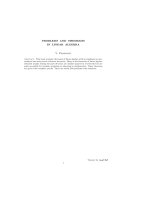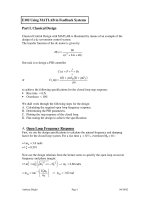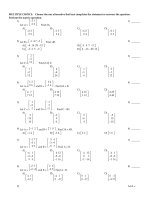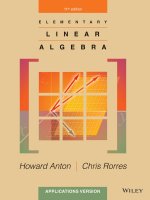using matlab in linear algebra
Bạn đang xem bản rút gọn của tài liệu. Xem và tải ngay bản đầy đủ của tài liệu tại đây (111 KB, 37 trang )
Edward Neuman
Department of Mathematics
Southern Illinois University at Carbondale
One of the nice features of MATLAB is its ease of computations with vectors and matrices. In
this tutorial the following topics are discussed: vectors and matrices in MATLAB, solving
systems of linear equations, the inverse of a matrix, determinants, vectors in n-dimensional
Euclidean space, linear transformations, real vector spaces and the matrix eigenvalue problem.
Applications of linear algebra to the curve fitting, message coding and computer graphics are also
included.
For the reader's convenience we include lists of special characters and MATLAB functions that
are used in this tutorial.
Special characters
;
Semicolon operator
'
Conjugated transpose
.'
Transpose
*
Times
.
Dot operator
^
Power operator
[ ]
Emty vector operator
:
Colon operator
=
Assignment
==
Equality
\
Backslash or left division
/
Right division
i, j
Imaginary unit
~
Logical not
~=
Logical not equal
&
Logical and
|
Logical or
{ }
Cell
2
Function Description
acos
Inverse cosine
axis
Control axis scaling and appearance
char
Create character array
chol
Cholesky factorization
cos
Cosine function
cross
Vector cross product
det
Determinant
diag
Diagonal matrices and diagonals of a matrix
double
Convert to double precision
eig
Eigenvalues and eigenvectors
eye
Identity matrix
fill
Filled 2-D polygons
fix
Round towards zero
fliplr
Flip matrix in left/right direction
flops
Floating point operation count
grid
Grid lines
hadamard
Hadamard matrix
hilb
Hilbert matrix
hold
Hold current graph
inv
Matrix inverse
isempty
True for empty matrix
legend
Graph legend
length
Length of vector
linspace
Linearly spaced vector
logical
Convert numerical values to logical
magic
Magic square
max
Largest component
min
Smallest component
norm
Matrix or vector norm
null
Null space
num2cell
Convert numeric array into cell array
num2str
Convert number to string
ones
Ones array
pascal
Pascal matrix
plot
Linear plot
poly
Convert roots to polynomial
polyval
Evaluate polynomial
rand
Uniformly distributed random numbers
randn
Normally distributed random numbers
rank
Matrix rank
reff
Reduced row echelon form
rem
Remainder after division
reshape
Change size
roots
Find polynomial roots
sin
Sine function
size
Size of matrix
sort
Sort in ascending order
3
subs
Symbolic substitution
sym
Construct symbolic bumbers and variables
tic
Start a stopwatch timer
title
Graph title
toc
Read the stopwatch timer
toeplitz
Tioeplitz matrix
tril
Extract lower triangular part
triu
Extract upper triangular part
vander
Vandermonde matrix
varargin
Variable length input argument list
zeros
Zeros array
The purpose of this section is to demonstrate how to create and transform vectors and matrices in
MATLAB.
This command creates a row vector
a = [1 2 3]
a =
1 2 3
Column vectors are inputted in a similar way, however, semicolons must separate the components
of a vector
b = [1;2;3]
b =
1
2
3
The quote operator ' is used to create the conjugate transpose of a vector (matrix) while the dot-
quote operator .' creates the transpose vector (matrix). To illustrate this let us form a complex
vector a + i*b' and next apply these operations to the resulting vector to obtain
(a+i*b')'
ans =
1.0000 - 1.0000i
2.0000 - 2.0000i
3.0000 - 3.0000i
while
4
(a+i*b').'
ans =
1.0000 + 1.0000i
2.0000 + 2.0000i
3.0000 + 3.0000i
Command length returns the number of components of a vector
length(a)
ans =
3
The dot operator. plays a specific role in MATLAB. It is used for the componentwise application
of the operator that follows the dot operator
a.*a
ans =
1 4 9
The same result is obtained by applying the power operator ^ to the vector a
a.^2
ans =
1 4 9
Componentwise division of vectors a and b can be accomplished by using the backslash operator
\ together with the dot operator .
a.\b'
ans =
1 1 1
For the purpose of the next example let us change vector a to the column vector
a = a'
a =
1
2
3
The dot product and the outer product of vectors a and b are calculated as follows
dotprod = a'*b
5
dotprod =
14
outprod = a*b'
outprod =
1 2 3
2 4 6
3 6 9
The cross product of two three-dimensional vectors is calculated using command cross. Let the
vector a be the same as above and let
b = [-2 1 2];
Note that the semicolon after a command avoids display of the result. The cross product of a and
b is
cp = cross(a,b)
cp =
1 -8 5
The cross product vector cp is perpendicular to both a and b
[cp*a cp*b']
ans =
0 0
We will now deal with operations on matrices. Addition, subtraction, and scalar multiplication are
defined in the same way as for the vectors.
This creates a 3-by-3 matrix
A = [1 2 3;4 5 6;7 8 10]
A =
1 2 3
4 5 6
7 8 10
Note that the semicolon operator ; separates the rows. To extract a submatrix B consisting of
rows 1 and 3 and columns 1 and 2 of the matrix A do the following
B = A([1 3], [1 2])
B =
1 2
7 8
To interchange rows 1 and 3 of A use the vector of row indices together with the colon operator
C = A([3 2 1],:)
6
C =
7 8 10
4 5 6
1 2 3
The colon operator : stands for all columns or all rows. For the matrix A from the last example
the following command
A(:)
ans =
1
4
7
2
5
8
3
6
10
creates a vector version of the matrix A. We will use this operator on several occasions.
To delete a row (column) use the empty vector operator [ ]
A(:, 2) = []
A =
1 3
4 6
7 10
Second column of the matrix A is now deleted. To insert a row (column) we use the technique for
creating matrices and vectors
A = [A(:,1) [2 5 8]' A(:,2)]
A =
1 2 3
4 5 6
7 8 10
Matrix A is now restored to its original form.
Using MATLAB commands one can easily extract those entries of a matrix that satisfy an impsed
condition. Suppose that one wants to extract all entries of that are greater than one. First, we
define a new matrix A
A = [-1 2 3;0 5 1]
A =
-1 2 3
0 5 1
7
Command A > 1 creates a matrix of zeros and ones
A > 1
ans =
0 1 1
0 1 0
with ones on these positions where the entries of A satisfy the imposed condition and zeros
everywhere else. This illustrates logical addressing in MATLAB. To extract those entries of the
matrix A that are greater than one we execute the following command
A(A > 1)
ans =
2
5
3
The dot operator . works for matrices too. Let now
A = [1 2 3; 3 2 1] ;
The following command
A.*A
ans =
1 4 9
9 4 1
computes the entry-by-entry product of A with A. However, the following command
A*A
¨??? Error using ==> *
Inner matrix dimensions must agree.
generates an error message.
Function diag will be used on several occasions. This creates a diagonal matrix with the diagonal
entries stored in the vector d
d = [1 2 3];
D = diag(d)
D =
1 0 0
0 2 0
0 0 3
8
To extract the main diagonal of the matrix D we use function diag again to obtain
d = diag(D)
d =
1
2
3
What is the result of executing of the following command?
diag(diag(d));
In some problems that arise in linear algebra one needs to calculate a linear combination of
several matrices of the same dimension. In order to obtain the desired combination both the
coefficients and the matrices must be stored in cells. In MATLAB a cell is inputted using curly
braces{ }. This
c = {1,-2,3}
c =
[1] [-2] [3]
is an example of the cell. Function lincomb will be used later on in this tutorial.
function M = lincomb(v,A)
% Linear combination M of several matrices of the same size.
% Coefficients v = {v1,v2,…,vm} of the linear combination and the
% matrices A = {A1,A2, ,Am} must be inputted as cells.
m = length(v);
[k, l] = size(A{1});
M = zeros(k, l);
for i = 1:m
M = M + v{i}*A{i};
end
!"
MATLAB has several tool needed for computing a solution of the system of linear equations.
Let A be an m-by-n matrix and let b be an m-dimensional (column) vector. To solve
the linear system Ax = b one can use the backslash operator \ , which is also called the left
division.
9
1.
Case m = n
In this case MATLAB calculates the exact solution (modulo the roundoff errors) to the system in
question.
Let
A = [1 2 3;4 5 6;7 8 10]
A =
1 2 3
4 5 6
7 8 10
and let
b = ones(3,1);
Then
x = A\b
x =
-1.0000
1.0000
0.0000
In order to verify correctness of the computed solution let us compute the residual vector r
r = b - A*x
r =
1.0e-015 *
0.1110
0.6661
0.2220
Entries of the computed residual r theoretically should all be equal to zero. This example
illustrates an effect of the roundoff erros on the computed solution
.
2.
Case m > n
If m > n, then the system Ax = b is overdetermined and in most cases system is inconsistent. A
solution to the system Ax = b, obtained with the aid of the backslash operator \ , is the least-
squares solution.
Let now
A = [2 –1; 1 10; 1 2];
and let the vector of the right-hand sides will be the same as the one in the last example. Then
10
x = A\b
x =
0.5849
0.0491
The residual r of the computed solution is equal to
r = b - A*x
r =
-0.1208
-0.0755
0.3170
Theoretically the residual r is orthogonal to the column space of A. We have
r'*A
ans =
1.0e-014 *
0.1110
0.6994
3.
Case m < n
If the number of unknowns exceeds the number of equations, then the linear system is
underdetermined. In this case MATLAB computes a particular solution provided the system is
consistent. Let now
A = [1 2 3; 4 5 6];
b = ones(2,1);
Then
x = A\b
x =
-0.5000
0
0.5000
A general solution to the given system is obtained by forming a linear combination of x with the
columns of the null space of A. The latter is computed using MATLAB function null
z = null(A)
z =
0.4082
-0.8165
0.4082
11
Suppose that one wants to compute a solution being a linear combination of x and z, with
coefficients 1 and –1. Using function lincomb we obtain
w = lincomb({1,-1},{x,z})
w =
-0.9082
0.8165
0.0918
The residual r is calculated in a usual way
r = b - A*w
r =
1.0e-015 *
-0.4441
0.1110
#$
The built-in function rref allows a user to solve several problems of linear algebra. In this section
we shall employ this function to compute a solution to the system of linear equations and also to
find the rank of a matrix. Other applications are discussed in the subsequent sections of this
tutorial.
Function rref takes a matrix and returns the reduced row echelon form of its argument. Syntax of
the rref command is
B = rref(A)
or
[B, pivot] = rref(A)
The second output parameter pivot holds the indices of the pivot columns.
Let
A = magic(3); b = ones(3,1);
A solution x to the linear system Ax = b is obtained in two steps. First the augmented matrix of
the system is transformed to the reduced echelon form and next its last column is extracted
[x, pivot] = rref([A b])
x =
1.0000 0 0 0.0667
0 1.0000 0 0.0667
0 0 1.0000 0.0667
pivot =
1 2 3
12
x = x(:,4)
x =
0.0667
0.0667
0.0667
The residual of the computed solution is
b - A*x
ans =
0
0
0
Information stored in the output parameter pivot can be used to compute the rank of the matrix A
length(pivot)
ans =
3
% &
MATLAB function inv is used to compute the inverse matrix.
Let the matrix A be defined as follows
A = [1 2 3;4 5 6;7 8 10]
A =
1 2 3
4 5 6
7 8 10
Then
B = inv(A)
B =
-0.6667 -1.3333 1.0000
-0.6667 3.6667 -2.0000
1.0000 -2.0000 1.0000
In order to verify that B is the inverse matrix of A it sufficies to show that A*B = I and
B*A = I, where I is the 3-by-3 identity matrix. We have
13
A*B
ans =
1.0000 0 -0.0000
0 1.0000 0
0 0 1.0000
In a similar way one can check that B*A = I.
The Pascal matrix, named in MATLAB pascal, has several interesting properties. Let
A = pascal(3)
A =
1 1 1
1 2 3
1 3 6
Its inverse B
B = inv(A)
B =
3 -3 1
-3 5 -2
1 -2 1
is the matrix of integers. The Cholesky triangle of the matrix A is
S = chol(A)
S =
1 1 1
0 1 2
0 0 1
Note that the upper triangular part of S holds the binomial coefficients. One can verify easily that
A = S'*S.
Function rref can also be used to compute the inverse matrix. Let A is the same as above. We
create first the augmented matrix B with A being followed by the identity matrix of the same size
as A. Running function rref on the augmented matrix and next extracting columns four through
six of the resulting matrix, we obtain
B = rref([A eye(size(A))]);
B = B(:, 4:6)
B =
3 -3 1
-3 5 -2
1 -2 1
14
To verify this result, we compute first the product A *B
A*B
ans =
1 0 0
0 1 0
0 0 1
and next B*A
B*A
ans =
1 0 0
0 1 0
0 0 1
This shows that B is indeed the inverse matrix of A.
' (
In some applications of linear algebra knowledge of the determinant of a matrix is required.
MATLAB built-in function det is designed for computing determinants.
Let
A = magic(3);
Determinant of A is equal to
det(A)
ans =
-360
One of the classical methods for computing determinants utilizes a cofactor expansion. For more
details, see e.g., [2], pp. 103-114.
Function ckl = cofact(A, k, l) computes the cofactor ckl of the a
kl
entry of the matrix A
function ckl = cofact(A,k,l)
% Cofactor ckl of the a_kl entry of the matrix A.
[m,n] = size(A);
if m ~= n
error('Matrix must be square')
15
end
B = A([1:k-1,k+1:n],[1:l-1,l+1:n]);
ckl = (-1)^(k+l)*det(B);
Function d = mydet(A) implements the method of cofactor expansion for computing
determinants
function d = mydet(A)
% Determinant d of the matrix A. Function cofact must be
% in MATLAB's search path.
[m,n] = size(A);
if m ~= n
error('Matrix must be square')
end
a = A(1,:);
c = [];
for l=1:n
c1l = cofact(A,1,l);
c = [c;c1l];
end
d = a*c;
Let us note that function mydet uses the cofactor expansion along the row 1 of the matrix A.
Method of cofactors has a high computational complexity. Therefore it is not recommended for
computations with large matrices. Its is included here for pedagogical reasons only. To measure a
computational complexity of two functions det and mydet we will use MATLAB built-in
function flops. It counts the number of floating-point operations (additions, subtractions,
multiplications and divisions). Let
A = rand(25);
be a 25-by-25 matrix of uniformly distributed random numbers in the interval ( 0, 1 ). Using
function det we obtain
flops(0)
det(A)
ans =
-0.1867
flops
ans =
10100
For comparison, a number of flops used by function mydet is
flops(0)
16
mydet(A)
ans =
-0.1867
flops
ans =
223350
The adjoint matrix adj(A) of the matrix A is also of interest in linear algebra (see, e.g., [2],
p.108).
function B = adj(A)
% Adjoint matrix B of the square matrix A.
[m,n] = size(A);
if m ~= n
error('Matrix must be square')
end
B = [];
for k = 1:n
for l=1:n
B = [B;cofact(A,k,l)];
end
end
B = reshape(B,n,n);
The adjoint matrix and the inverse matrix satisfy the equation
A
-1
= adj(A)/det(A)
(see [2], p.110 ). Due to the high computational complexity this formula is not recommended for
computing the inverse matrix.
)
The 2-norm (Euclidean norm) of a vector is computed in MATLAB using function norm.
Let
a = -2:2
a =
-2 -1 0 1 2
The 2-norm of a is equal to
twon = norm(a)
17
twon =
3.1623
With each nonzero vector one can associate a unit vector that is parallel to the given vector. For
instance, for the vector a in the last example its unit vector is
unitv = a /twon
unitv =
-0.6325 -0.3162 0 0.3162 0.6325
The angle
θ
between two vectors a and b of the same dimension is computed using the formula
= arccos(a.b/||a|| ||b||),
where a.b stands for the dot product of a and b, ||a|| is the norm of the vector a and arccos is the
inverse cosine function.
Let the vector a be the same as defined above and let
b = (1:5)'
b =
1
2
3
4
5
Then
angle = acos((a*b)/(norm(a)*norm(b)))
angle =
1.1303
Concept of the cross product can be generalized easily to the set consisting of n -1 vectors in the
n-dimensional Euclidean space
n
. Function crossprod provides a generalization of the
MATLAB function cross.
function cp = crossprod(A)
% Cross product cp of a set of vectors that are stored in columns of A.
[n, m] = size(A);
if n ~= m+1
error('Number of columns of A must be one less than the number of
rows')
18
end
if rank(A) < min(m,n)
cp = zeros(n,1);
else
C = [ones(n,1) A]';
cp = zeros(n,1);
for j=1:n
cp(j) = cofact(C,1,j);
end
end
Let
A = [1 -2 3; 4 5 6; 7 8 9; 1 0 1]
A =
1 -2 3
4 5 6
7 8 9
1 0 1
The cross product of column vectors of A is
cp = crossprod(A)
cp =
-6
20
-14
24
Vector cp is orthogonal to the column space of the matrix A. One can easily verify this by
computing the vector-matrix product
cp'*A
ans =
0 0 0
*
Let L:
n
m
be a linear transformation. It is well known that any linear transformation in
question is represented by an m-by-n matrix A, i.e., L(x) = Ax holds true for any x
n
.
Matrices of some linear transformations including those of reflections and rotations are discussed
in detail in Tutorial 4, Section 4.3.
With each matrix one can associate four subspaces called the four fundamental subspaces. The
subspaces in question are called the column space, the nullspace, the row space, and the left
19
nullspace. First two subspaces are tied closely to the linear transformations on the finite-
dimensional spaces.
Throughout the sequel the symbols (L) and (L) will stand for the range and the kernel of the
linear transformation L, respectively. Bases of these subspaces can be computed easily. Recall
that (L) = column space of A and (L) = nullspace of A. Thus the problem of computing the
bases of the range and the kernel of a linear transformation L is equivalent to the problem of
finding bases of the column space and the nullspace of a matrix that represents transformation L.
Function fourb uses two MATLAB functions rref and null to campute bases of four fundamental
subspaces associated with a matrix A.
function [cs, ns, rs, lns] = fourb(A)
% Bases of four fundamental vector spaces associated
% with the matrix A.
% cs- basis of the column space of A
% ns- basis of the nullspace of A
% rs- basis of the row space of A
% lns- basis of the left nullspace of A
[V, pivot] = rref(A);
r = length(pivot);
cs = A(:,pivot);
ns = null(A,'r');
rs = V(1:r,:)';
lns = null(A','r');
In this example we will find bases of four fundamental subspaces associated with the random
matrix of zeros and ones.
This set up the seed of the randn function to 0
randn('seed',0)
Recall that this function generates normally distributed random numbers. Next a 3-by-5 random
matrix is generated using function randn
A = randn(3,5)
A =
1.1650 0.3516 0.0591 0.8717 1.2460
0.6268 -0.6965 1.7971 -1.4462 -0.6390
0.0751 1.6961 0.2641 -0.7012 0.5774
The following trick creates a matrix of zeros and ones from the random matrix A
A = A >= 0
A =
1 1 1 1 1
1 0 1 0 0
1 1 1 0 1
20
Bases of four fundamental subspaces of matrix A are now computed using function fourb
[cs, ns, rs, lns] = fourb(A)
cs =
1 1 1
1 0 0
1 1 0
ns =
-1 0
0 -1
1 0
0 0
0 1
rs =
1 0 0
0 1 0
1 0 0
0 0 1
0 1 0
lns =
Empty matrix: 3-by-0
Vectors that form bases of the subspaces under discussion are saved as the column vectors.
The Fundamental Theorem of Linear Algebra states that the row space of A is orthogonal to the
nullspace of A and also that the column space of A is orthogonal to the left nullspace of A
(see [6] ). For the bases of the subspaces in this example we have
rs'*ns
ans =
0 0
0 0
0 0
cs'*lns
ans =
Empty matrix: 3-by-0
+ ,
In this section we discuss some computational tools that can be used in studies of real vector
spaces. Focus is on linear span, linear independence, transition matrices and the Gram-Schmidt
orthogonalization.
21
Linear span
Concept of the linear span of a set of vectors in a vector space is one of the most important ones
in linear algebra. Using MATLAB one can determine easily whether or not given vector is in the
span of a set of vectors. Function span takes a vector, say v, and an unspecified numbers of
vectors that form a span. All inputted vectors must be of the same size. On the output a message
is displayed to the screen. It says that either v is in the span or that v is not in the span.
function span(v, varargin)
% Test whether or not vector v is in the span of a set
% of vectors.
A = [];
n = length(varargin);
for i=1:n
u = varargin{i};
u = u';
A = [A u(:)];
end
v = v';
v = v(:);
if rank(A) == rank([A v])
disp(' Given vector is in the span.')
else
disp(' Given vector is not in the span.')
end
The key fact used in this function is a well-known result regarding existence of a solution to the
system of linear equations. Recall that the system of linear equations Ax = b possesses a solution
iff rank(A) = rank( [A b] ). MATLAB function varargin used here allows a user to enter a
variable number of vectors of the span.
To test function span we will run this function on matrices. Let
v = ones(3);
and choose matrices
A = pascal(3);
and
B = rand(3);
to determine whether or not v belongs to the span of A and B. Executing function span we obtain
span(v, A, B)
Given vector is not in the span.
22
Linear independence
Suppose that one wants to check whether or not a given set of vectors is linearly independent.
Utilizing some ideas used in function span one can write his/her function that will take an
uspecified number of vectors and return a message regarding linear independence/dependence of
the given set of vectors. We leave this task to the reader (see Problem 32).
Transition matrix
Problem of finding the transition matrix from one vector space to another vector space is interest
in linear algebra. We assume that the ordered bases of these spaces are stored in columns of
matrices T and S, respectively. Function transmat implements a well-known method for finding
the transition matrix.
function V = transmat(T, S)
% Transition matrix V from a vector space having the ordered
% basis T to another vector space having the ordered basis S.
% Bases of the vector spaces are stored in columns of the
% matrices T and S.
[m, n] = size(T);
[p, q] = size(S);
if (m ~= p) | (n ~= q)
error('Matrices must be of the same dimension')
end
V = rref([S T]);
V = V(:,(m + 1):(m + n));
Let
T = [1 2;3 4]; S = [0 1;1 0];
be the ordered bases of two vector spaces. The transition matrix V form a vector space having the
ordered basis T to a vector space whose ordered basis is stored in columns of the matrix S is
V = transmat(T, S)
V =
3 4
1 2
We will use the transition matrix V to compute a coordinate vector in the basis S. Let
[x]
T
=
1
1
be the coordinate vector in the basis T. Then the coordinate vector [x]
S
, is
xs = V*[1;1]
23
xs =
7
3
Gram-Schmidt orthogonalization
Problem discussed in this subsection is formulated as follows. Given a basis A = {u
1
, u
2
, … , u
m
}
of a nonzero subspace W of
n
. Find an orthonormal basis V = {v
1
, v
2
, … , v
m
} for W.
Assume that the basis S of the subspace W is stored in columns of the matrix A, i.e.,
A = [u
1
; u
2
; … ; u
m
], where each u
k
is a column vector. Function gs(A) computes an orthonormal
basis V for W using a classical method of Gram and Schmidt.
function V = gs(A)
% Gram-Schmidt orthogonalization of vectors stored in
% columns of the matrix A. Orthonormalized vectors are
% stored in columns of the matrix V.
[m,n] = size(A);
for k=1:n
V(:,k) = A(:,k);
for j=1:k-1
R(j,k) = V(:,j)'*A(:,k);
V(:,k) = V(:,k) - R(j,k)*V(:,j);
end
R(k,k) = norm(V(:,k));
V(:,k) = V(:,k)/R(k,k);
end
Let W be a subspace of
3
and let the columns of the matrix A, where
=
13
12
11
A
form a basis for W. An orthonormal basis V for W is computed using function gs
V = gs([1 1;2 1;3 1])
V =
0.2673 0.8729
0.5345 0.2182
0.8018 -0.4364
To verify that the columns of V form an orthonormal set it sufficies to check that V
T
V = I. We
have
24
V'*V
ans =
1.0000 0.0000
0.0000 1.0000
We will now use matrix V to compute the coordinate vector [v]
V
, where
v = [1 0 1];
We have
v*V
ans =
1.0690 0.4364
-&
MATLAB function eig is designed for computing the eigenvalues and the eigenvectors of the
matrix A. Its syntax is shown below
[V, D] = eig(A)
The eigenvalues of A are stored as the diagonal entries of the diagonal matrix D and the
associated eigenvectors are stored in columns of the matrix V.
Let
A = pascal(3);
Then
[V, D] = eig(A)
V =
0.5438 -0.8165 0.1938
-0.7812 -0.4082 0.4722
0.3065 0.4082 0.8599
D =
0.1270 0 0
0 1.0000 0
0 0 7.8730
Clearly, matrix A is diagonalizable. The eigenvalue-eigenvector decomposition A = VDV
-1
of A
is calculated as follows
V*D/V
25
ans =
1.0000 1.0000 1.0000
1.0000 2.0000 3.0000
1.0000 3.0000 6.0000
Note the use of the right division operator / instead of using the inverse matrix function inv. This
is motivated by the fact that computation of the inverse matrix takes longer than the execution of
the right division operation.
The characteristic polynomial of a matrix is obtained by invoking the function poly.
Let
A = magic(3);
be the magic square. In this example the vector chpol holds the coefficients of the characteristic
polynomial of the matrix A. Recall that a polynomial is represented in MATLAB by its
coefficients that are ordered by descending powers
chpol = poly(A)
chpol =
1.0000 -15.0000 -24.0000 360.0000
The eigenvalues of A can be computed using function roots
eigenvals = roots(chpol)
eigenvals =
15.0000
4.8990
-4.8990
This method, however, is not recommended for numerical computing the eigenvalues of a matrix.
There are several reasons for which this approach is not used in numerical linear algebra. An
interested reader is referred to Tutorial 4.
The Caley-Hamilton Theorem states that each matrix satisfies its characteristic equation, i.e.,
chpol(A) = 0, where the last zero stands for the matrix of zeros of the appropriate dimension. We
use function lincomb to verify this result
Q = lincomb(num2cell(chpol), {A^3, A^2, A, eye(size(A))})
Q =
1.0e-012 *
-0.5684 -0.5542 -0.4832
-0.5258 -0.6253 -0.4547
-0.5116 -0.4547 -0.6821









